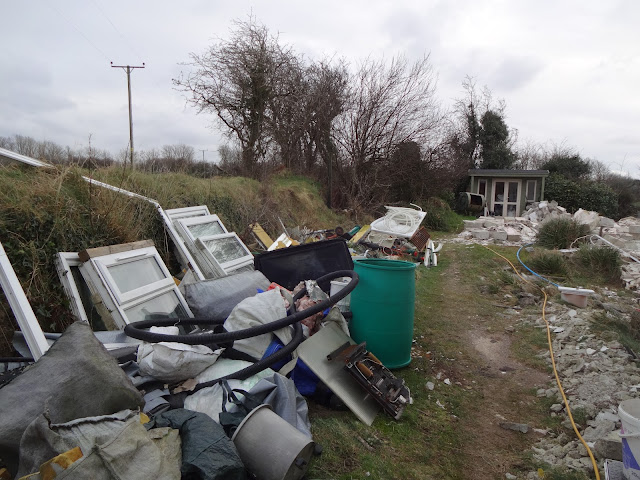RUBBLE TROUBLE.
With the worst of the winter gone, it was time to resume the demolition of the old house. We'd managed to sell anything of value on Ebay, but were still left with piles of rubbish that needed to be cleared.
Anything that couldn't be burnt or sold would have to be chucked out, so we hired a skip.
With
some careful packing we were hoping to fit all of the rubbish in one
skip (skips are very expensive these days...) We started by loading all
the biggest, heaviest items, like the old steel kerosene tank,
radiators, oil boiler, and UPVC windows and doors
There
was so much junk, but we managed to cram most of it into the skip. A
lot more was wedged in after this picture was taken and by the time it
was collected it was piled high.
Back at the site, we needed to break up all the concrete floors, but in order to get to them, we would first need to clear away a lot of the fallen rubble.
Each of the large blocks weighed around 50kg (that's two bags of cement), so we had to break most of them up into halves or quarters just so we could comfortably carry them to the various rubble piles that were forming around the perimeter.
More rubble needed clearing on the west side; the gable wall on this side had been particularly hard to demolish as the walls were more like a solid concrete bunker.
Gradually we shifted the blocks out to the sides and started to expose the concrete floor slab.
Luckily there didn't appear to be any foundations under the house (which would have meant even more concrete to break up). The lowest blocks appeared to have been laid directly onto any old bits of slate that they found lying around when they originally built the place and had a thick layer of soil under them in place of mortar! That partially explains the horrendous problem with damp in that house.
Once we'd cleared the blocks, we could start demolishing the floor using an electric breaker. This particular section was pretty weak so luckily didn't take too long to smash up...
...but as ever, this accursed house was going to make things as difficult as possible for us and having removed one slab, we found another (much harder) concrete slab was hidden underneath. Sigh.
Finally that section was gone so we moved on to the next and repeated the process.
The site inspector arrived to conduct a through audit of our progress.
That's about half of the floors taken up.
Unfortunately there was a LOT of hardcore buried underneath the floors too. We didn't remove it as we planned to hire a crusher later and would need a firm base on which to operate.
All the concrete we had excavated from the floors, was creating several more mountainous piles of rubble. We were getting concerned with the amount of material that we would have to deal with; for a small bungalow it seemed a ridiculous amount of rubble.
The other side of the floor needed a lot of clearing, thanks to all the additional slate and bricks from the top half of the fireplace.
Once cleared, the slab in this section of the house (our old bedroom) looked quite soft but also much higher and newer than the other floors.
There was something a bit odd about that floor... could this conceal the hidden treasure we'd been hoping for?
As we gradually cleared the site, we were getting a better idea of what the garden was going to look like and began to start planning what we might do with the space.
The view from the main bedroom looked very different and so much brighter now the old house was gone.
Before:
After:
The already-mountainous rubble piles were growing bigger by the day...
The old tiled kitchen floor was next...
It was all going so well. Only one section of concrete left and this was the 'suspiciously' new slab that we hoped concealed the long-awaited treasure.
With the slab removed we could finally peel back the plastic membrane and see what riches we had underneath...
Asbestos.
Lots of asbestos!
Nooooooo!
During the demolition, we'd seen a couple of bits of asbestos pinned in the roof which suggested the property had once been lined with it. It was clear that rather than pay to have it removed, they'd simply buried it under the floor. Or perhaps unscrupulous builders had taken money to dispose of it and buried it under the new floor when the owner wasn't looking. Either way, once again this accursed house was simply refusing to go quietly and we were left with another expensive mess to sort out.
It's not the most dangerous type of asbestos, but we still did not take any chances and a disposable hazmat suit and respirator were required. First step was to dampen it all down to reduce the amount of dust and fibres...
... then pick each piece up carefully by hand and load it into strong rubble bags...
... which we then carried out to the front of the property (this is about half of them - we ended up with about 40 bags - grrr). Each bag was then sealed and loaded into another bag which was also sealed. Nobody would take the asbestos unless it had been double-bagged.
It was a great relief when we'd finally cleared all the asbestos. The irresponsible attitude of the previous builders had cost us a lot of extra aggravation, time and money.
At last we'd finished all the floors. The site inspector arrived in his company vehicle and toured the site before giving it his final approval.











































No comments :
Post a Comment